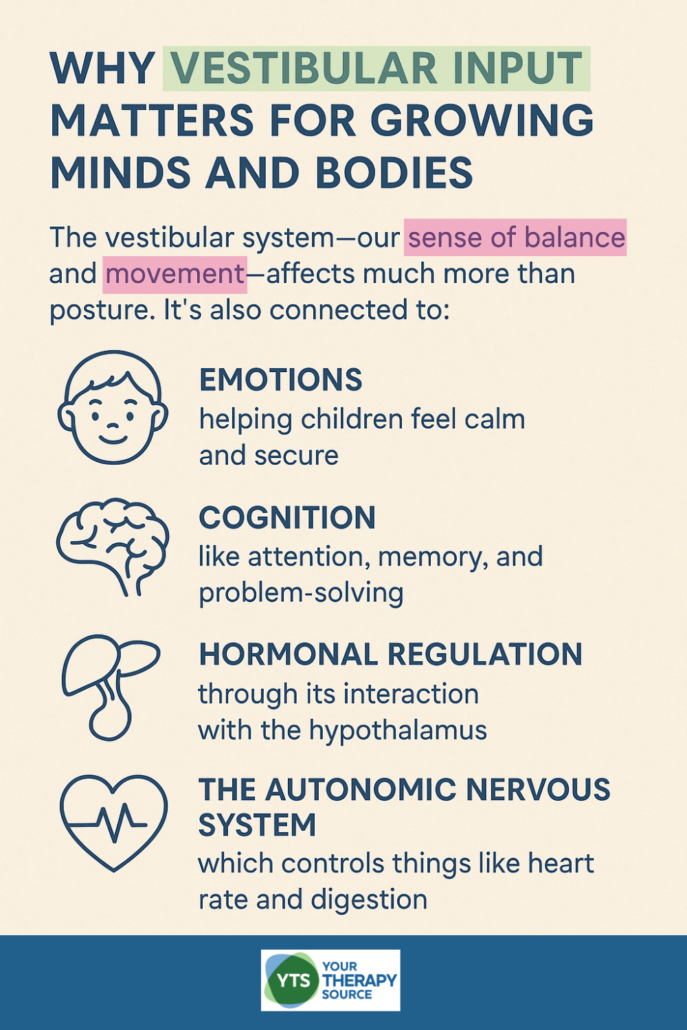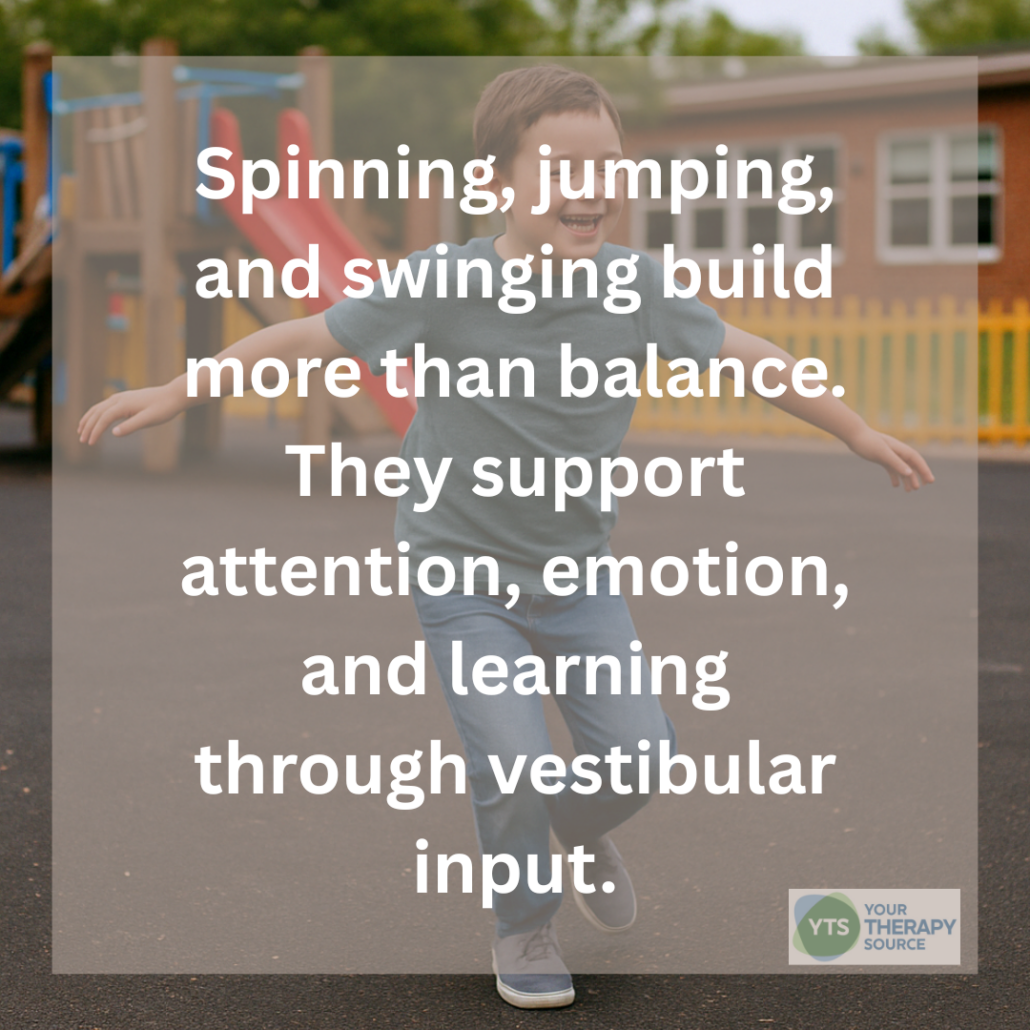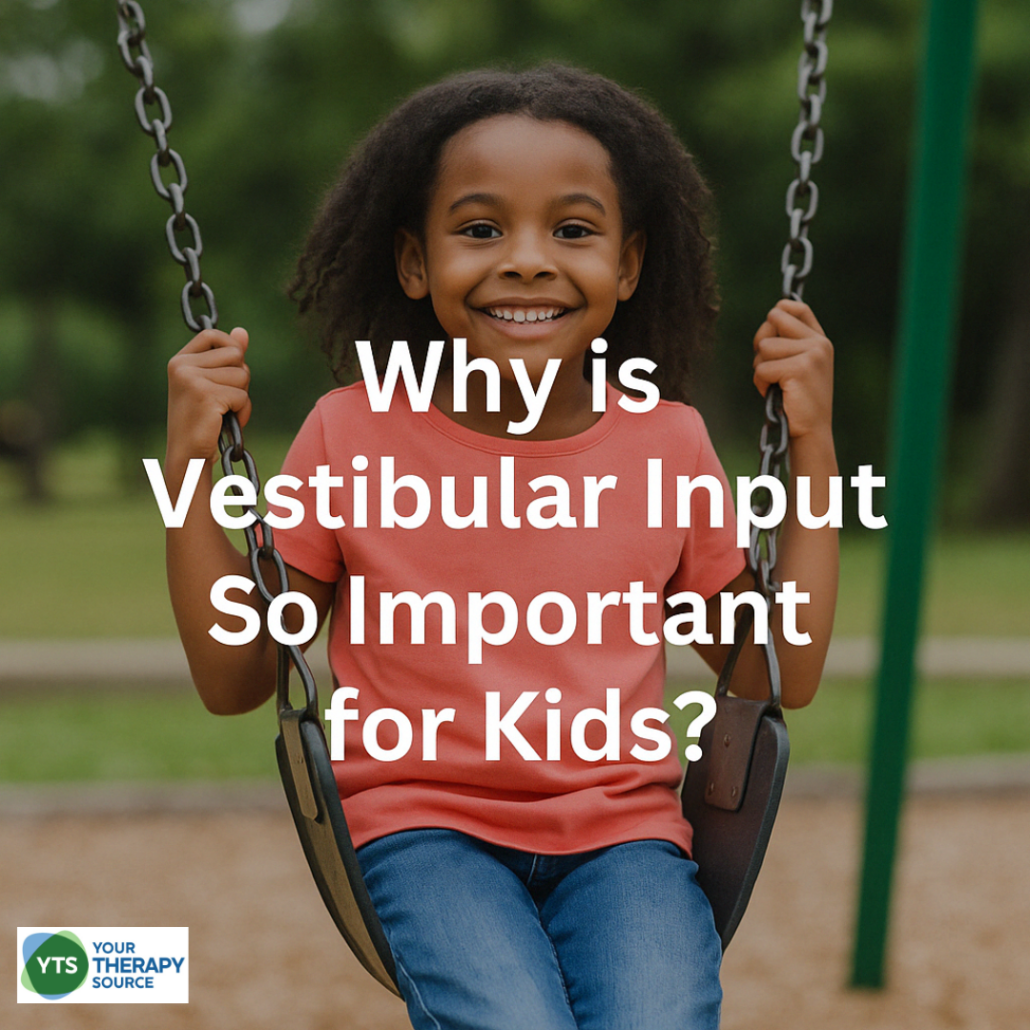Why Vestibular Input Matters for Growing Minds and Bodies
The vestibular system, our sense of balance and movement, is so much more than just helping kids stay upright. It’s one of the earliest systems to develop and one of the most essential for a child’s physical, emotional, and cognitive growth. Understanding and supporting this system through movement and play can make a huge difference in how children learn, feel, and function.

What Is the Vestibular System?
The vestibular system is located in the inner ear. It helps the brain understand how the head and body move through space. This allows children to maintain balance, stay upright, coordinate their movements, and keep their vision steady during motion.
But vestibular input isn’t only about movement. It affects many other parts of a child’s development and daily life, including emotions, thinking, and even how the body handles stress and regulation.
How the Vestibular System Affects the Whole Body
The vestibular system shares close connections with multiple areas of the brain. These connections help regulate important functions that go beyond posture and balance.
Emotions
The vestibular system is connected to the limbic system, which plays a major role in emotions and memory. That’s why movement—like swinging or rocking—can help calm a child. It helps regulate the nervous system, offering a sense of security and emotional balance.
Children with vestibular challenges may also struggle with emotional regulation, which shows how important this sensory input is for feeling safe, calm, and in control.
Cognition
Vestibular input supports learning, focus, memory, and problem-solving. The vestibular system sends information to areas of the brain involved in attention and spatial awareness, including the hippocampus and prefrontal cortex.
Children who don’t receive enough vestibular input through movement may have difficulty with reading, writing, math, and staying focused in the classroom. In contrast, movement-rich experiences help strengthen the brain for learning.
Hormonal Regulation
The vestibular system shares direct connections with the hypothalamus, a part of the brain that plays a key role in hormone regulation. The hypothalamus helps control body temperature, hunger, sleep, stress response, and growth through its influence on the endocrine system.
When the vestibular system is activated through movement, it can send signals to the hypothalamus, helping the body manage stress, regulate sleep-wake cycles, and maintain internal balance. While the science is still developing, research suggests this connection is one way the body keeps its systems working smoothly in response to movement.
The Autonomic Nervous System
The autonomic nervous system manages automatic body functions like heart rate, breathing, and digestion. Vestibular input plays a role in regulating these systems by providing information about where the body is in space and how it’s moving.
This helps children shift between states of alertness and calm. For example, fast spinning may increase arousal and energy, while slow rocking may help calm the body. This connection supports overall body regulation and stress management.

The Vestibular System Develops Through Movement
The physical structures of the vestibular system are mostly developed before birth, but the brain pathways that interpret and use this sensory input continue to mature through adolescence.
That development depends on active movement—especially during early childhood. When children crawl, roll, spin, jump, swing, and climb, they’re not just playing. They’re strengthening brain connections that support everything from balance to learning and emotional control.
Unfortunately, many children today spend a large portion of their time sitting, especially with increased screen time. Studies show that more than half of a child’s waking hours are spent in non-active states. Without regular vestibular input, their motor and cognitive development may be affected.
Activities That Support Vestibular Development
Parents, teachers, and therapists can help support the vestibular system with simple, everyday activities. These don’t require special equipment or long sessions—just movement that challenges the body in different directions.
Try incorporating these into your daily routine:
- Swinging (linear or spinning)
- Jumping on trampolines, cushions, or beds
- Rolling across the floor or down a hill
- Climbing playground equipment
- Dancing to music
- Scootering or bike riding
- Spinning games like ring-around-the-rosy
- Movement songs and obstacle courses
For more visual supports and activity ideas, read this post – Vestibular Input.
Supporting Children’s Development Through Movement
When we give children regular opportunities for movement, we’re doing more than helping them burn off energy. We’re supporting their brain and body development, helping them learn better, regulate emotions, and feel safe in their environment.
Whether you’re a parent encouraging play at home or a teacher allowing movement breaks in the classroom, you’re helping build a foundation for lifelong success. Movement fuels development—and the vestibular system is at the heart of that process.
Reference
Božanić Urbančič, N., Battelino, S., & Vozel, D. (2023). Appropriate Vestibular Stimulation in Children and Adolescents—A Prerequisite for Normal Cognitive, Motor Development and Bodily Homeostasis—A Review. Children, 11(1), 2.



